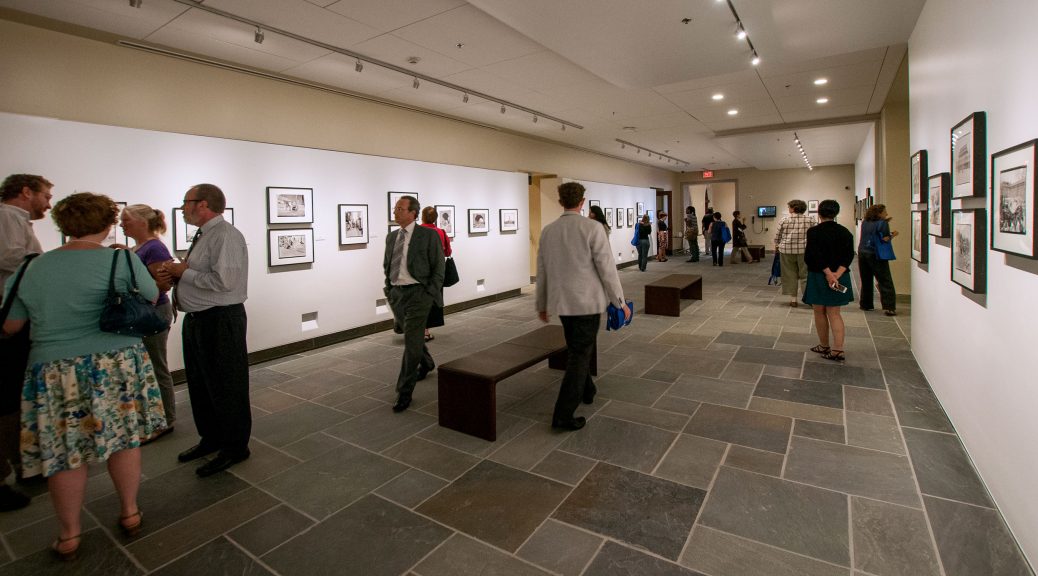As part of the Rubenstein Library Renovation Project a few years ago, the Special Collections Hallway Gallery was enlarged and rebranded as the Rubenstein Photography Gallery. The 67′ by 25′ space features a different collection from the Archive of Documentary Arts every few months. Because it still functions as a primary route through the building, the gallery provides an inviting environment for visitors to experience the library’s photographic collections.

We have been monitoring the environmental conditions within the space continually since it reopened in 2015. Although the temperature stays very stable in the building throughout the year, we do see some fluctuation in the relative humidity (RH) for the gallery. In the coldest winter months, public spaces tend to become very dry because of the heating systems. The question has been lingering in our minds: what are the environmental conditions that the artwork is experiencing inside the frame? Last fall, a small working group from Conservation, Exhibitions, Preservation, and the Archive of Documentary Arts gathered to design a simple experiment to try and answer this question.
As part of this experiment, we wanted to not only measure the temperature and RH within our normal frames, but see if there was something simple we could do to buffer any changes to those conditions. While there are many options available to change the conditions inside a frame, we determined the easiest (and cheapest) option would be to seal frame contents in a relatively impermeable package.

Framed photographs in our galleries include several components inside each frame. The glazing of our frames is a UV-filtering acrylic. Beneath that is a window mat cut to the size of the artwork. The print is mounted to another piece of mat board underneath. At the back of the package is a piece of corrugated board made of white plastic (polypropylene). We hypothesized that by taping the outside edges of this “package” of material with polypropylene tape that the air exchange inside the frame could be significantly reduced and therefore reduce the change in RH. We decided to set up two identical frames for comparison, one with a sealed package and one without.
We acquired two HOBO MX2300 Temp/RH dataloggers with external sensors and I set to work fitting them into two of our standard gallery frames.
 The datalogger sensor is much thicker than the art that usually goes inside one of these frames, so I had to build up the thickness of the package with several layers of mat board. I created a central stack of mat board with a window cut to fit the sensor. I chose not to use full sheets of mat board for a couple of reasons:
The datalogger sensor is much thicker than the art that usually goes inside one of these frames, so I had to build up the thickness of the package with several layers of mat board. I created a central stack of mat board with a window cut to fit the sensor. I chose not to use full sheets of mat board for a couple of reasons:
- We have a lot of small scrap pieces already and I didn’t want to waste materials.
- Frame packages typically only have one full mat board sheet and window mat inside. Adding five or more full sheets to the package seemed like a lot of additional material, which might act as added RH buffer.
- The rate of change between the two frames was the important variable. As long as each package was constructed with the same quantity of material inside, we should be able to get a representative comparison.
An inkjet print with a cut mat and the glazing was placed on top of the sensor. The sensor cable was passed through a hole cut in the corrugated plastic, allowing me to mount the logger to the back of the frame. The contents were all stored in a stable 45% RH environment for several weeks before installation. With the package all together, I sealed up the outer edges as well as the hole in the plastic backing with clear tape. The sealed package was then placed inside the metal and wood frames.

We installed our sealed and unsealed experiment frames in the gallery in early December 2017, along with a new show. The frames were mounted on a small wall, next to the window to our reading room, so as to be less of a distraction from the rest of the exhibit and to be in close proximity to the data logger which monitors the gallery space.

The inkjet prints we included in each frame had a short description of the experiment so that curious patrons would understand the the purpose of their unusual positioning.
After five months, we took the frames down and compiled all the environmental data. In the graph below, the gallery conditions are marked in grey, the unsealed frame is marked in yellow, and the sealed frame is marked in blue. Temperature values are displayed on the left, while RH values are displayed on the right.
The data confirms that the space maintains temperature very well, staying right around 70 degrees Fahrenheit. The RH in the gallery space does bounce around quite a bit throughout the winter months, fluctuating between around 50% and 20%. Late January 2018 seems to have been particularly volatile.
We were very surprised at how well each frame responded to the conditions in the gallery. Even inside the unsealed frame, we see a significant smoothing out of the RH graph: the over 30 point spread of the gallery RH is reduced to around 12% change in the unsealed frame and the contents did not drop below 30% RH. The sealed frame package performed very well, with only about 6% overall RH change in 5 months.
While the methodology of this experiment does have flaws, it is an inexpensive and adaptable approach to measuring environmental conditions. We can be reassured that our normal framing practices protect prints from drastic changes, even in the most volatile months. We can also take the relatively simple and cost-effective step of sealing the frame package to provide additional protection for more sensitive materials. This experiment has raised questions of how other methods, such as sealing the frame package differently or adding pre-conditioned board, might compare. It is likely that our investigations will continue, so that we can make the best choices for our collections.





